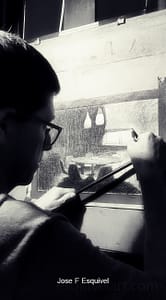
José Fabio Esquivel (b. 1974) is a contemporary charcoal artist whose work explores liminal territories and psychological landscapes through dramatic chiaroscuro technique. Working exclusively in charcoal on paper, Esquivel creates highly detailed compositions that examine the emotional states of individuals existing at society’s margins. His practice transforms spaces of potential isolation—urban thresholds, forest clearings, and architectural boundaries—into what he terms “transitional refuges.”
Esquivel’s current body of work, the “Liminal Sanctuaries” series, represents two years of intensive exploration into threshold spaces where displaced individuals find unexpected refuge. Drawing from his background in psychology and distinctive perceptual sensitivity, combined with extensive study of European and Russian academic drawing traditions , his compositions function as visual psychology experiments that capture the subtle narratives existing in everyday spaces. His artistic development progressed from classical portrait, still life, and landscape studies to his current personal expression through charcoal, requiring 40-60 hours per work to achieve the atmospheric depth and psychological precision that characterizes his practice.
Born in San Ramón de Alajuela, Costa Rica in 1974, Esquivel studied Philosophy and later Psychology with psychoanalytic focus. He dedicated himself to drawing, concentrating on portrait, still life, and landscape before transitioning to charcoal to develop a more personal artistic expression. He maintains his studio in Alajuela, Costa Rica, while developing work for North American and local collectors. His integrated practice includes the interest for furniture design, which informs his exceptional ability to render architectural spaces with psychological precision. Esquivel is currently seeking gallery representation and preparing his “Liminal Sanctuaries” series for exhibition.